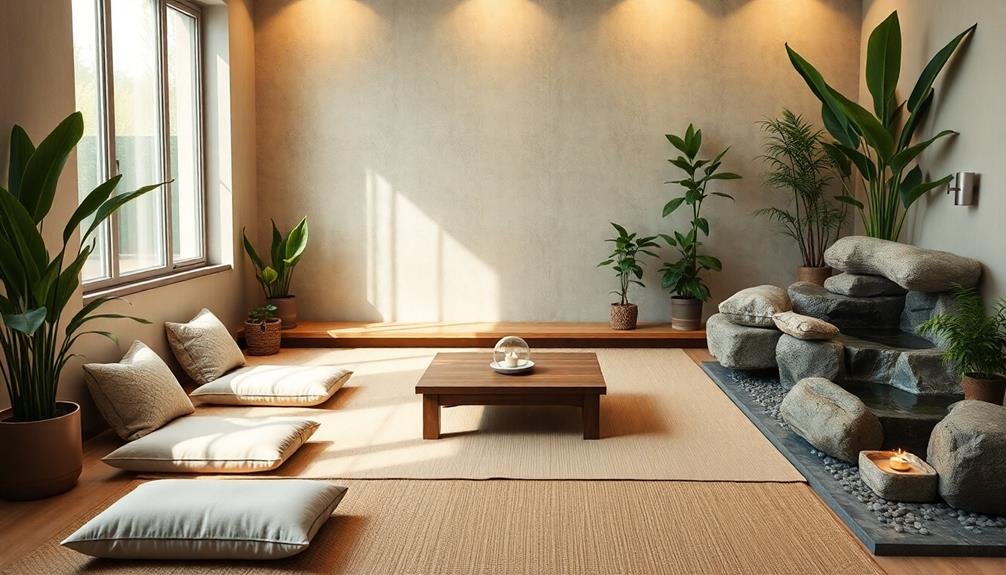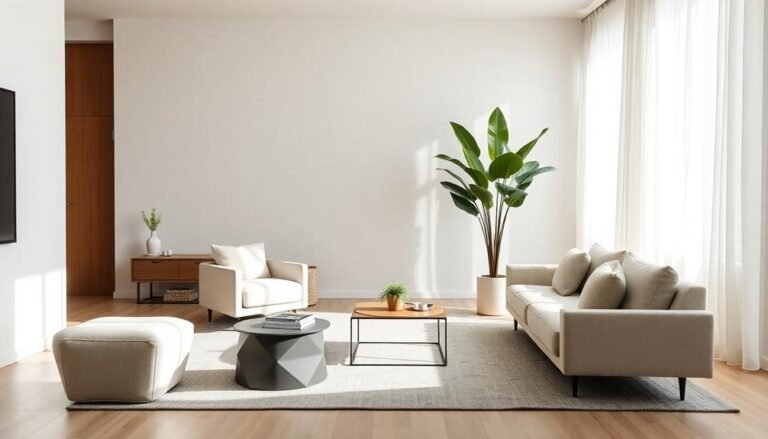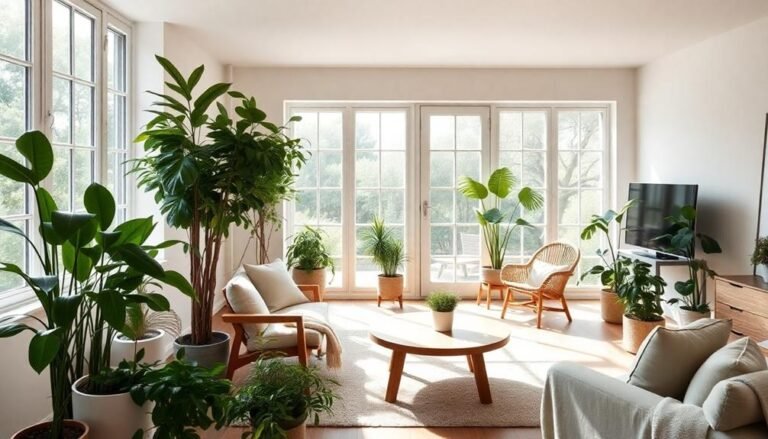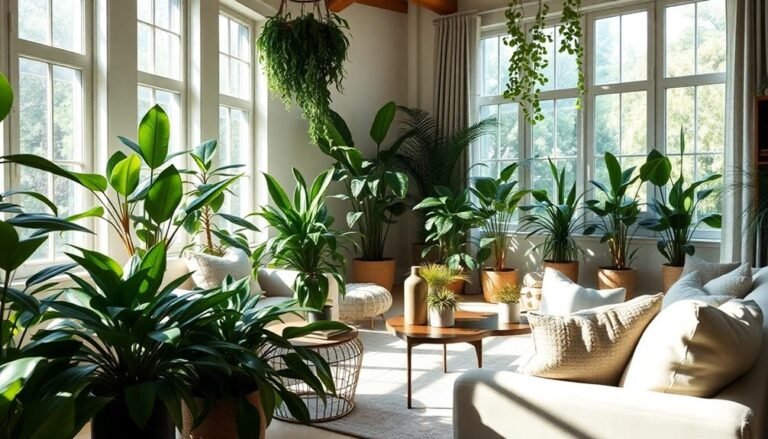Creating a home meditation space starts with selecting a calm, inviting location, away from distractions. Choose a cozy corner or a sunlit room that offers good ventilation. Essential items include a supportive cushion or chair, soft lighting, and perhaps a low table for candles or incense. Incorporate natural elements like indoor plants, wooden furnishings, and soothing sounds, such as a tabletop fountain. Personalize your space with meaningful decor and uplifting colors to enhance peace. Maintaining this space through regular decluttering and care keeps it serene and focused. Explore more ideas to truly cultivate your perfect retreat for mindfulness.
Choosing the Right Location

When choosing the right location for your home meditation space, focus on finding a spot that feels calm and inviting. Look for areas in your home that naturally promote serenity, such as a quiet corner, a sunlit room, or even a space near a window where you can connect with nature. It's crucial to minimize distractions, so avoid high-traffic areas or places near loud appliances. Think about the energy of the space; you want to feel at peace when you enter it.
Consider the time of day you plan to meditate. If you're an early riser, a room that catches the morning light might be ideal. Conversely, if you prefer evening sessions, choose a location that feels cozy and warm as the sun sets. You might also want to verify your chosen spot has good ventilation or fresh air, as this can enhance your meditation experience.
Lastly, make it personal. Adding elements that resonate with you—like plants or calming art—can enhance your sense of peace. Your meditation space should be a reflection of your own journey, offering a sanctuary where you can reconnect with yourself and recharge.
Essential Furniture and Accessories

Creating a comfortable and functional meditation space requires thoughtful selection of essential furniture and accessories. Start with a meditation cushion or mat, as these provide a supportive base for your practice. A firm, yet soft cushion can help you maintain proper posture while sitting, allowing you to focus on your breathing and mindfulness. Consider exploring various meditation cushions that cater to different preferences and needs to find one that resonates with you.
Next, consider adding a low table or shelf to hold items that enhance your practice, such as candles, incense, or a small altar. This can serve as a focal point for your meditation, creating a sense of ritual and intention.
If you prefer a seated position, a meditation chair can be a great addition. Look for one that offers ergonomic support, so you can sit comfortably for longer periods.
Lastly, think about soft lighting, like lamps or string lights, to create a calming atmosphere. Avoid harsh fluorescent lighting, as it can be distracting and counterproductive.
Incorporating Nature Elements

Incorporating elements of nature into your meditation space can greatly enhance the calming atmosphere you've already begun to cultivate. One effective way to do this is by adding plants. Indoor greenery not only purifies the air but also brings a sense of serenity and life into the room. Consider placing a small potted fern or a peace lily nearby; their gentle presence can help ground your thoughts during meditation. Additionally, plants like the ZZ Plant are low-maintenance options that thrive in various light conditions, making them perfect for any meditation space.
You might also want to include natural materials in your decor. Wooden furniture, bamboo mats, or stone accents can create a warm, inviting feel. For instance, a simple wooden bench or a cork yoga block can serve both practical and aesthetic purposes. Additionally, incorporating water elements, like a small tabletop fountain, can provide soothing sounds that promote relaxation.
Textures matter too. Soft cotton blankets or linen cushions with earthy tones can evoke the feeling of being outside. Finally, think about the scents of nature. Essential oils or natural incense, like sandalwood or lavender, can transport you to a peaceful forest or a serene garden, enhancing your mindfulness practice and deepening your connection to nature.
Setting the Mood With Lighting

The right lighting can transform your meditation space into a sanctuary of peace and serenity. To create a calming atmosphere, contemplate using soft, warm lights that can enhance your mindfulness practice. You could opt for adjustable lamps or dimmers, allowing you to tailor the brightness to your comfort level. Natural light is also beneficial, so if possible, position your space near a window to take advantage of daylight. For ideas on creating the perfect relaxing ambiance, explore lighting fixtures for relaxation.
Here are three effective lighting options to contemplate:
- Candles: The flickering glow of candles not only provides a gentle light but also adds a soothing aroma, enhancing relaxation.
- Fairy Lights: Stringing fairy lights around your meditation area can create a magical ambiance without being overwhelming, making it ideal for quiet reflection.
- Salt Lamps: These lamps emit a warm, soft glow and are believed to purify the air, which may add to your overall sense of peace.
Adding Personal Touches

Your meditation space can truly reflect your personality and intentions by adding personal touches that resonate with you. Start by incorporating items that hold special meaning, like a cherished photograph, a piece of art, or a small sculpture that inspires you. These elements can serve as reminders of your goals and values, enhancing your meditation experience.
Next, think about the scents that bring you comfort. You might consider using essential oils or scented candles, as they can evoke feelings of peace and serenity. A calming lavender scent or invigorating citrus fragrance can help create a soothing atmosphere.
In addition, textiles can add warmth and comfort to your space. A soft blanket, a plush cushion, or even a unique rug can make your area more inviting. Choose colors and patterns that uplift you, allowing your meditation space to feel like a personal sanctuary.
Maintaining Your Meditation Space

Maintaining a meditation space is essential for fostering a consistent practice and guaranteeing it remains a sanctuary for reflection. Regular upkeep not only enhances the aesthetics but also deepens your connection to this peaceful area. By dedicating a few minutes each week to care for your space, you reinforce its purpose in your life.
Here are some tips to help maintain your meditation space:
- Declutter regularly: Clear away distractions, like old items or excess decor, to keep the area focused and serene. A tidy environment promotes a calm mind.
- Refresh your elements: Update your candles, incense, or plants to keep the space inviting. New scents or colors can rejuvenate your experience and invite fresh energy.
- Assess your comfort: Guarantee your cushion or chair remains comfortable and supportive. If it's worn out, replace it to maintain a cozy atmosphere for your practice.
Frequently Asked Questions
How Often Should I Meditate in My Dedicated Space?
You should aim to meditate daily if possible, even if just for a few minutes. Consistency builds the habit, allowing you to reap the benefits over time. Start with shorter sessions, gradually increasing their length as you feel more comfortable. If daily practice feels overwhelming, try meditating a few times a week. The key is to find a rhythm that fits your lifestyle, making meditation a natural part of your routine.
Can I Use My Meditation Space for Other Activities?
Your meditation space can be as versatile as a Swiss Army knife, serving multiple purposes. While it's designed for mindfulness, you can definitely use it for activities like reading, journaling, or yoga. Just make certain the environment remains conducive to relaxation. For instance, if you're reading, maintain a calming atmosphere by keeping clutter at bay. Ultimately, it's about creating a space that supports your well-being, regardless of the activity you choose.
What if I Have Limited Space for a Meditation Area?
If you've got limited space for a meditation area, don't worry. You can create a calming environment in small corners or even a nook in your bedroom. Use a cushion or a chair, and keep it tidy with minimal decor. Consider incorporating portable items like a small mat or a jar of calming scents. Even a dedicated time each day can transform any small space into a personal oasis for mindfulness and relaxation.
Should I Meditate With or Without Music?
Whether you should meditate with or without music depends on your personal preference. Some find that soft music enhances their focus, creating a soothing backdrop for their practice, while others feel music can be distracting. You might try both methods and observe which one helps you achieve a deeper state of relaxation. Consider starting with gentle instrumental tracks and gradually experimenting with silence to discover what resonates best for your meditation experience.
How Do I Stay Motivated to Use My Meditation Space Regularly?
To stay motivated in your meditation practice, set a consistent schedule and treat it like an important appointment. Start with shorter sessions, gradually increasing their length as you grow more comfortable. You might also track your progress in a journal, noting how you feel before and after each session. Surrounding yourself with reminders, like calming images or quotes, can inspire you to return. Remember, consistency fosters a deeper connection and enhances the benefits of meditation.




